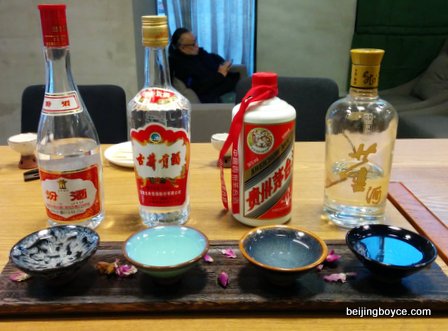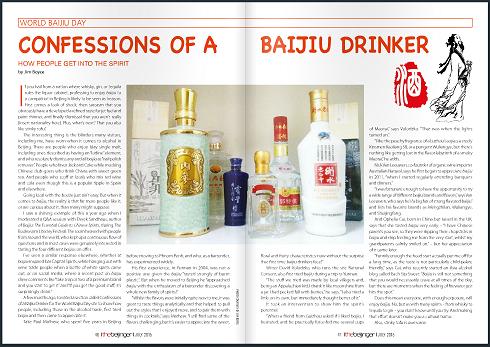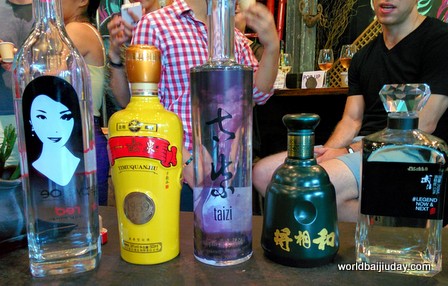

Last year’s inaugural World Baijiu Day featured events in 20 cities, from Beijing to Brussels, from Shanghai to Sydney, from London to Los Angeles. We’re back for 2016 and, with six weeks to go, will be in even more cities for this year’s party on August 9.
Lots of people hate baijiu due to crazy ganbei sessions and hangovers that cause nausea at the mere sight of a bottle and/or due to aromas and flavors they fine weird and/or due to the strength of a spirit that often packs a punch at 52 percent alcohol.
That’s why our informal thee is “beyond ganbei“, namely, to try baijiu in terms of cocktails or liqueurs or beers or food pairings or even foods themselves such as the drunken shrimp pizzas by Gung Ho, deep-fried baijiu by Windy City and gummy bears by Alex J. The key word is try: many people outside China haven’t even heard of baijiu, despite it having more global sales than gin, vodka or whisky, and the idea is for them to at least give it a shot.
There are also people who have come to know and like baijiu, either via experiences in China or the growing number of brands, cocktails and infusions available in the world’s bars and restaurants. I talked to a half-dozen of them last year for a series called Confessions of a Baijiu Drinker and will be talking to more this year, too. Learn how these people first tried baijiu, what brands they like and some of their more amusing experiences:
- David Volodzko: “I returned to China in 2012 and cracked open a Red Star from time to time, but only as a means of letting loose. I couldn’t get into the flavor. When a friend from Guizhou asked if I liked baijiu, I hesitated, and he practically force-fed me several cups of Maotai. That was when the lights turned on.”
- Lao San: “…during my three years in Wuhan, I discovered that locals actually drink baijiu like the French drink wine—as something to be sipped and appreciated rather than knocked back between bites of food. It was there that I also tasted a wide range of baijius from fiery hot to smooth and subtle. It was then that I began to appreciate the diversity of baijiu.”
- Paul Mathew: “There were techniques similar to agricole rum production, flavours reminiscent of tequila and grappa, clay pot ageing that was new to me, and a whole new classification system for spirits based on their fragrance. Whilst the flavours were initially quite new to me, it was great to taste things analytically and that helped to pull out the styles that I enjoyed more, and to pair them with things in cocktails.”
- Nick van Leeuwen: “I am a big fan of strong-flavored baijiu. My three favorite baijius are Mengzhilan, Wuliangye and Shuijingfang. As a foreigner calling Beijing home, I also can’t go past a bottle of light-flavoured erguotou with some local friends.”
- Derek Sandhaus: “My first attempt at a tasting involved buying two or three bottles and bringing them out to dinner with some friends. I remember we had a cheap bottle of Moutai and some Luzhou Laojiao on the table… You wouldn’t have known them for the same liquor if they weren’t both labelled baijiu… This was a bit of an a-ha moment for me.”
- Andy Benson: “No matter what type of baijiu, the best part for me is the drinking “ritual”. This includes the order of the toasting, the ability to show respect by lowering the rim of your glass, and even being the one who must drink if the tail of the fish at dinner is pointing at you!”
- Jim Boyce: “It was 1999, we were in Inner Mongolia checking off the sleep-in-a-yurt box and a tour guide told us it was still Chinese New Year. He opened a bottle of baijiu and threw some on the campfire. His grin as it exploded into flames should have served as a warning but instead we wanted to try a shot.”
You can also learn more about World Baijiu Day here.
* * *
Get regular Beijing updates via my Instagram and Twitter feeds. Also see my sibling sites Grape Wall of China, World Baijiu Day and World Marselan Day. Help cover the hosting and other costs of these sites with a WeChat, AliPay or PayPal donation.* * *


Leave a Reply